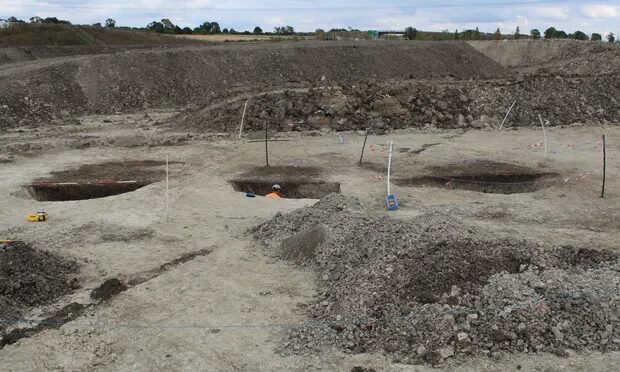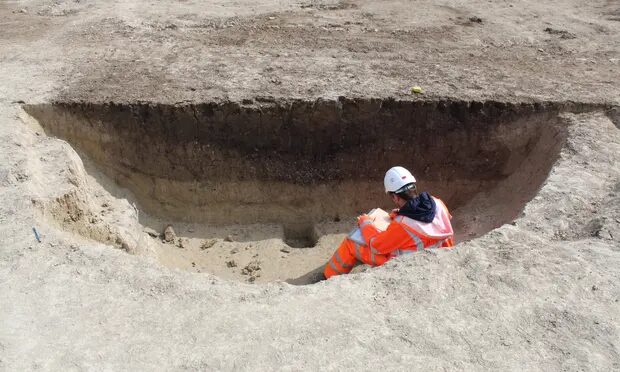
The pits could offer extraordinary new insights. They are in alignments and clustered around former stream channels, suggesting a spiritual significance.
Such is the scale of this site that it has more such pits in a single area than anywhere else in England and Wales, including Stonehenge. Radiocarbon dating revealed they are from 7,700 to 8,500 years ago.
Archaeologists from the Museum of London Archaeology (Mola), who are conducting the research, said: "This date makes the site incredibly significant because there are very few Mesolithic sites in the UK that are this substantial. Evidence from this period is often slim, only consisting of flint tools and occasional butchered animal remains."
Prof Joshua Pollard, an expert from Southampton University who has worked on big projects in the Stonehenge and Avebury landscapes, described the discovery as very exciting.
He said: "While we know of other large and enigmatic pits dug by hunter-gatherers from elsewhere in Britain, including at Stonehenge, the Linmere pits are striking because of their number and the wide area they cover."
Digging such vast pits would have been an extraordinary feat. Measuring up to 5 metres (16.4ft) wide and 1.85 metres deep, each one is round with steep sides, some flaring out into a wider base.
The site has been explored as part of two separate development projects. Albion Archaeology worked on one area and Mola excavated another. Inside some of the pits, the archaeologists found animal bones, a "crucial source of evidence". The remains of aurochs, a wild species of cattle, are among them, with evidence that people had feasted on them.
Yvonne Wolframm-Murray, a project officer at Mola, said the discovery was completely unexpected: "We knew there was archaeology, but didn't initially know we had Mesolithic pits until the radiocarbon dates came back. It's very exciting ... There's only a handful of known other sites with pits that are comparable, certainly quantity-wise."
The archaeologists have wondered whether the pits were used in hunting or storing food, but they believe their shape and size make such theories unlikely. They are struck by the way the pits were laid out in a number of straight lines, up to 500 metres long. While there are other Mesolithic pits dug in alignments in Britain, the Linmere alignments seem to be linked to former stream channels.

Wolframm-Murray said: "During the Mesolithic period, ice sheets covering much of the country retreated and sea levels rose, cutting off Britain from mainland Europe. This was a crucial time of transformation in the UK's past, and studying a site where people made such a mark on the landscape could have far-reaching impacts on how archaeologists understand these ancient communities."
There may be further pits yet to be found in the area. Archaeologists are analysing the finds and evidence in the lab. They hope to discover whether the pits were all dug and used at the same time, and understand more about the plants growing nearby. They have already identified evidence of oak, hazel and pine, and are studying pollen that has survived from the Mesolithic period.
Wolframm-Murray said: "This work will reveal the environment these people lived in, and hopefully answer the question 'what were these pits for?'"




Ho the world in which Archaeologists live 🤪